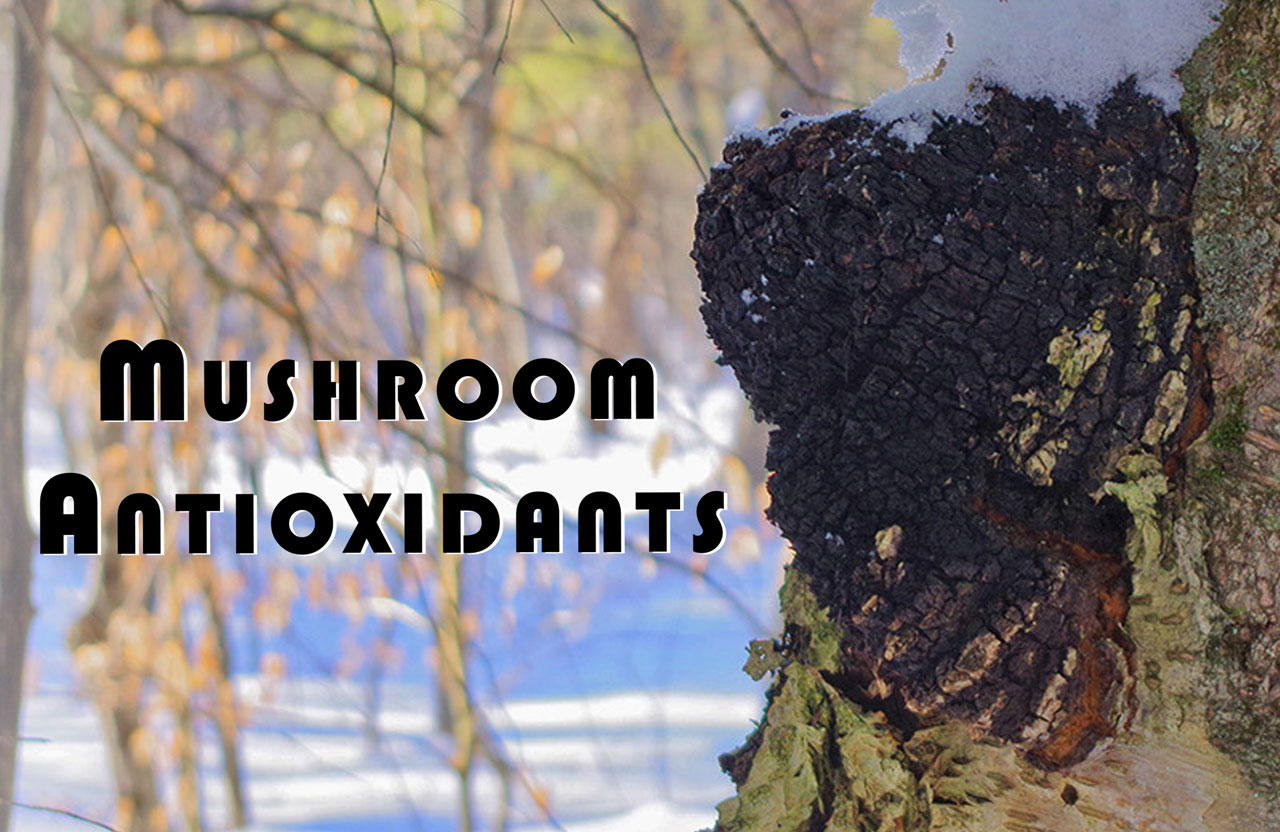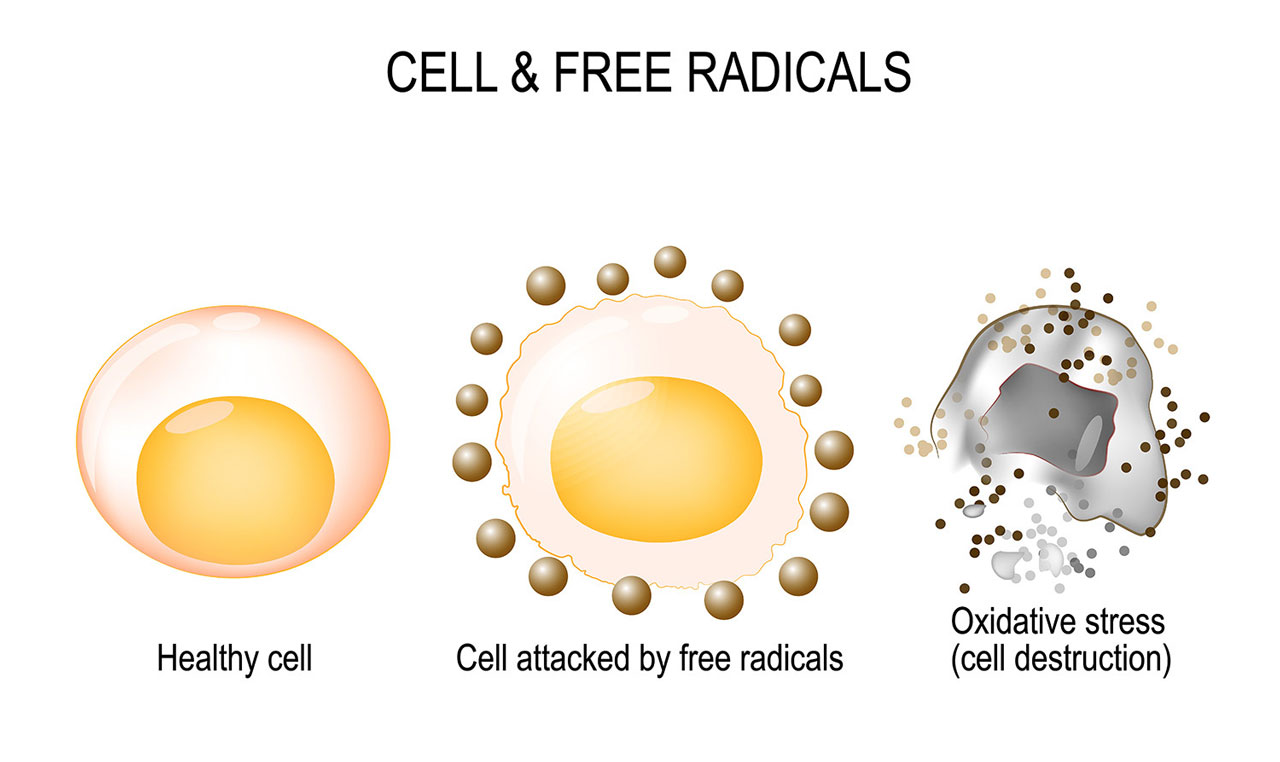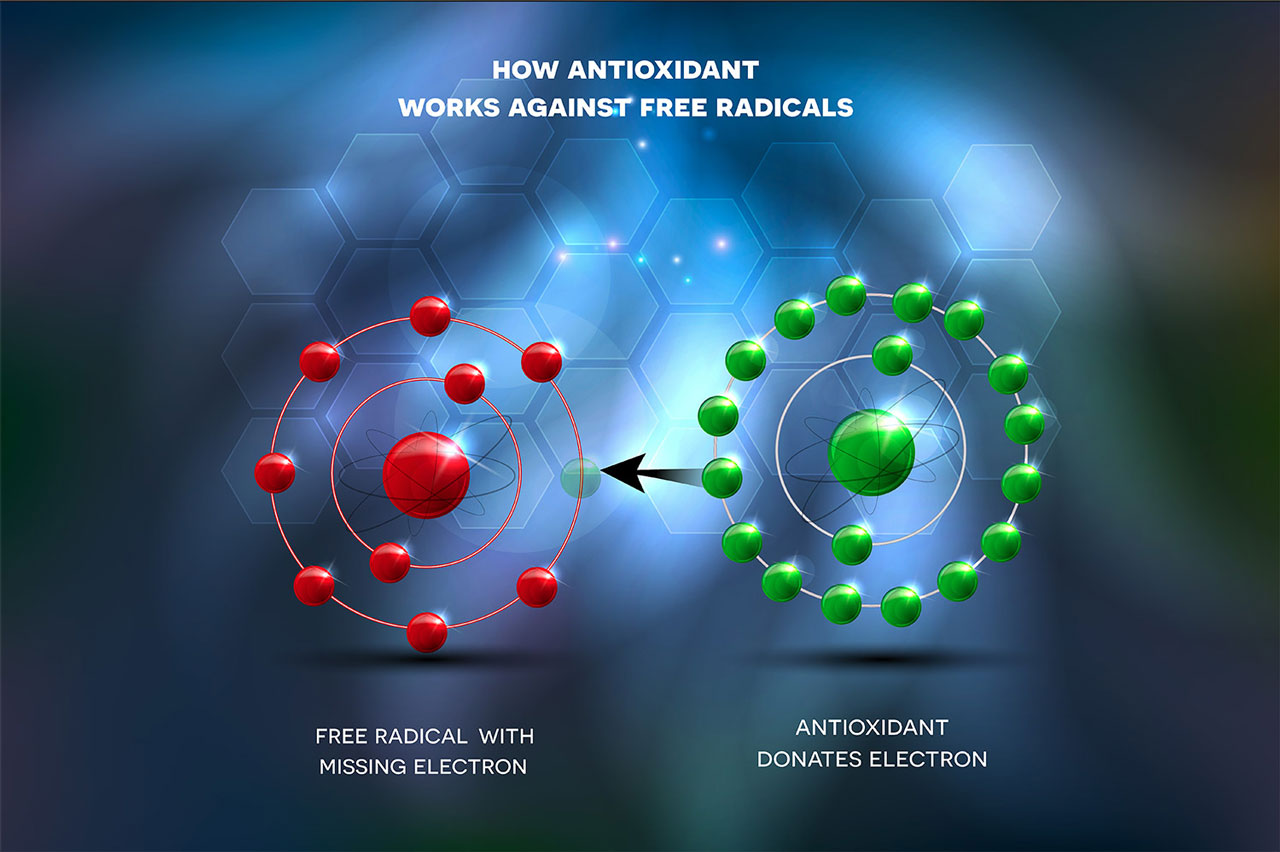Mushrooms as Potent Antioxidants
Anti-oxidants. Free radicals. We’ve heard these mentioned so often over the last few decades, with one side arguing that anti-oxidants are ineffectual, while the other side sings their praises. How can there be such contradictory points of view? Well, for a number of reasons, but first, we need to acknowledge that the research has been quite mixed. One key reason is that many of these studies used synthetic anti-oxidants that perform differently than natural ones. Also important is that the research does show more positive results when using multiple or complex anti-oxidants rather than one isolated compound (like you find in mushrooms). The bottom-line though, is that we know free radicals are problematic molecules in the human body and that high levels are associated with numerous, let’s just say, less than healthy situations. So let’s take a look at what free radicals and antioxidants are, then look at some food and nutritional sources followed by the gifts that mushrooms have to offer in this area.
What’s a Free Radical?
A free radical is a highly reactive and unstable molecule that contains one or more unpaired electrons in its outermost shell. These unpaired electrons make free radicals highly reactive because they seek to pair up with another electron to achieve stability. As a result, free radicals can react with other molecules in an attempt to steal an electron from them, leading to a chain reaction of molecular damage.
Free radicals can be generated in various ways, including normal cellular processes such as metabolism, as well as external sources like exposure to environmental toxins, pollutants, radiation, and certain drugs. Common examples of free radicals include superoxide (O2-), hydroxyl radical (OH·), and nitric oxide (NO·).
While free radicals are natural byproducts of normal cellular metabolism, excessive amounts of free radicals can be harmful to the body. When free radicals react with important cellular components such as DNA, proteins, and cell membranes, they can cause oxidative damage. This damage is associated with various diseases, including cancer, cardiovascular diseases, neurodegenerative disorders, and aging.
To counteract the harmful effects of free radicals, the body has a defense system that includes antioxidants. Antioxidants are molecules that can donate an electron to stabilize a free radical, thus neutralizing its reactivity. Consuming a diet rich in fruits, vegetables, and other sources of antioxidants, as well as leading a healthy lifestyle, can help reduce the negative impact of free radicals on the body.
Free Radicals and Health
Free radicals can have a significant impact on our health due to their ability to cause oxidative stress and damage cellular structures. Here are some ways in which free radicals can affect our health:
- Cellular damage: Free radicals can react with important cellular components such as DNA, proteins, and cell membranes. This oxidative damage can disrupt normal cellular function and lead to mutations in DNA, protein dysfunction, and lipid peroxidation, causing structural and functional impairments.
- Aging: Accumulation of oxidative damage over time is believed to contribute to the aging process. Free radicals can damage cellular structures and impair their function, leading to age-related changes in tissues and organs.
- Chronic diseases: Free radicals have been implicated in the development and progression of various chronic diseases. Oxidative stress caused by an imbalance between free radicals and antioxidants can contribute to conditions such as cardiovascular diseases, neurodegenerative disorders (e.g., Alzheimer’s and Parkinson’s disease), cancer, diabetes, and inflammatory conditions.
- Inflammation: Free radicals can activate inflammatory pathways in the body. Excessive free radical production can trigger an inflammatory response, leading to tissue damage and contributing to the development of chronic inflammatory conditions.
- Immune system dysfunction: Free radicals can impair the functioning of the immune system. Oxidative stress can affect immune cells, such as lymphocytes and macrophages, compromising their ability to fight infections and increasing susceptibility to illnesses.
- Environmental factors: Exposure to environmental toxins, pollutants, radiation, and certain drugs can increase the production of free radicals in the body. This heightened exposure to free radicals can exacerbate their negative effects on health.
It’s important to note that the body has mechanisms to counteract free radicals, such as antioxidants produced internally or obtained from the diet. A balance between free radicals and antioxidants is essential for maintaining optimal health. Consuming a diet rich in antioxidants, engaging in regular exercise, avoiding excessive exposure to environmental toxins, and adopting healthy lifestyle habits can help mitigate the harmful effects of free radicals on our health.
What are Anti-oxidants?
Antioxidants are molecules that can neutralize or inhibit the harmful effects of free radicals. They work by donating an electron to the free radical, thereby stabilizing it and preventing it from reacting with other molecules in the body. This process effectively terminates the chain reaction of oxidative damage caused by free radicals.
Antioxidants can be broadly categorized into two types: endogenous antioxidants and exogenous antioxidants.
- Endogenous antioxidants: These are antioxidants produced naturally within the body. Some examples include:
- Enzymatic antioxidants: Enzymes such as superoxide dismutase (SOD), catalase, and glutathione peroxidase help convert highly reactive free radicals into less harmful molecules.*
- Non-enzymatic antioxidants: These include molecules such as glutathione, coenzyme Q10, and uric acid, which can directly neutralize free radicals or regenerate other antioxidants.*
- Exogenous antioxidants: These are antioxidants that we obtain from external sources, primarily through our diet. Examples of exogenous antioxidants include:
- Vitamin C (ascorbic acid): Found in fruits and vegetables, vitamin C is a potent water-soluble antioxidant that can donate electrons to neutralize free radicals.*
- Vitamin E (tocopherols and tocotrienols): Present in nuts, seeds, and vegetable oils, vitamin E is a fat-soluble antioxidant that protects cell membranes from oxidative damage.*
- Carotenoids: These include beta-carotene, lycopene, and lutein, which are found in colorful fruits and vegetables. Carotenoids help neutralize free radicals and protect against oxidative stress.*
- Flavonoids: Widely present in fruits, vegetables, tea, and cocoa, flavonoids possess antioxidant properties and may contribute to overall health benefits.*
When antioxidants neutralize free radicals, they themselves become oxidized. However, the body has mechanisms to regenerate and recycle antioxidants, allowing them to continue their protective role.
 It’s important to note that while antioxidants are beneficial, consuming excessive amounts of antioxidant supplements may not necessarily provide added benefits and could potentially have adverse effects. A balanced diet rich in fruits, vegetables, whole grains, and other nutrient-dense foods is generally recommended to ensure an adequate intake of antioxidants and other essential nutrients.
It’s important to note that while antioxidants are beneficial, consuming excessive amounts of antioxidant supplements may not necessarily provide added benefits and could potentially have adverse effects. A balanced diet rich in fruits, vegetables, whole grains, and other nutrient-dense foods is generally recommended to ensure an adequate intake of antioxidants and other essential nutrients.
There are numerous antioxidants that offer beneficial effects, and their effectiveness can vary depending on the specific context and the type of free radicals they encounter. Here are some notable antioxidants known for their effectiveness:
- Vitamin C (ascorbic acid): Vitamin C is a powerful water-soluble antioxidant that can donate electrons to neutralize free radicals in both aqueous and lipid environments. It plays a crucial role in the regeneration of vitamin E and enhances the antioxidant capacity of other compounds in the body.*
- Vitamin E (tocopherols and tocotrienols): Vitamin E is a fat-soluble antioxidant that protects cell membranes from oxidative damage by trapping free radicals in lipid-rich areas. Alpha-tocopherol is the most biologically active form of vitamin E.*
- Glutathione: Glutathione is a potent endogenous antioxidant that is found in high concentrations within cells. It plays a critical role in cellular defense against oxidative stress and helps regenerate other antioxidants, such as vitamins C and E.*
- Selenium: Selenium is a trace mineral that acts as a cofactor for various antioxidant enzymes, including glutathione peroxidase. It helps protect cells from oxidative damage and supports the proper functioning of the immune system.*
- Carotenoids: Carotenoids, such as beta-carotene, lycopene, and lutein, are pigment compounds found in colorful fruits and vegetables. They possess antioxidant properties and have been associated with reducing the risk of chronic diseases, particularly certain types of cancer and eye conditions.*
- Flavonoids: Flavonoids are a diverse group of plant compounds found in fruits, vegetables, tea, cocoa, and propolis. They have antioxidant and anti-inflammatory properties and may contribute to the health benefits associated with plant-based diets.*
It’s important to note that the effectiveness of antioxidants can depend on factors such as their concentration, bioavailability, interactions with other compounds, and the specific conditions in which they are acting. A balanced and varied diet that includes a wide range of antioxidant-rich foods is generally recommended to obtain the collective benefits of different antioxidants. Additionally, antioxidants are most effective when consumed as part of a healthy lifestyle, including regular physical activity, stress management, and avoidance of excessive exposure to environmental toxins.
Mushrooms as Anti-oxidants
Many mushrooms possess antioxidant properties and can contribute to a healthy diet. Here are a few examples of mushrooms known for their antioxidant content:
- Reishi Mushroom (Ganoderma lucidum): Reishi mushrooms are highly regarded for their potential health benefits. They contain various bioactive compounds, including triterpenoids and polysaccharides, which exhibit antioxidant and immunomodulatory properties.*
- Shiitake Mushroom (Lentinula edodes): Shiitake mushrooms are rich in compounds like polysaccharides, flavonoids, and phenolic acids. These components contribute to their antioxidant and anti-inflammatory effects, potentially providing protection against oxidative stress. They contain a compound called ergothioneine, which acts as an antioxidant and may help protect against oxidative damage in the body.*
- Maitake Mushroom (Grifola frondosa): Maitake mushrooms contain polysaccharides, particularly beta-glucans, which have demonstrated antioxidant and immune-stimulating properties. They may help reduce oxidative damage and support overall health. These antioxidants can help combat oxidative stress, support immune function, and have been studied for their potential anti-inflammatory properties.*
- Tremella mushroom (Tremella fuciformis) possess significant antioxidant activity and is a type of edible mushroom commonly used in traditional Chinese cuisine and traditional medicine (as a Yin tonic). It has been consumed for centuries due to its potential health benefits. Tremella mushroom is also known for its moisturizing and skin-rejuvenating effects, this, along with its antioxidant actions make it a wonderful ally to support skin health.*
- Poria mushroom (Poria cocos) is a medicinal mushroom commonly used in traditional Chinese medicine. It contains various bioactive compounds, including triterpenoids, polysaccharides, and phenols, which are believed to contribute to its antioxidant effects. Studies have shown that Poria extracts can scavenge free radicals, inhibit lipid peroxidation (the process of oxidative damage to lipids), and increase the activity of antioxidant enzymes in the body. Poria has also demonstrated the ability to protect cells from oxidative damage and support healthy inflammatory response.*
- Lion’s Mane Mushroom (Hericium erinaceus): Lion’s Mane mushrooms contain unique compounds, including hericenones and erinacines. These compounds have been associated with antioxidant and neuroprotective effects, potentially supporting brain health.*
- Coriolus Mushroom (Trametes versicolor): Coriolus is commonly known as Turkey Tail and is one of the best researched mushroom allies, including clinical studies confirming its antioxidant properties. According to a study published in the journal Antioxidants, Coriolus was able to restore glutathione (GSH) levels and catalase and superoxide dismutase (SOD) activities, while reducing lipid peroxidation, nitrite and reactive oxygen species (ROS) levels.*
- Royal Agaricus Mushroom (Agaricus blazei): Royal Agaricus, also known as the almond mushroom or the “mushroom of god”, is a medicinal mushroom that is native to Brazil. It has been used traditionally to enhance wellbeing and support healthy immune response. Royal Agaricus is also a source of antioxidants, including flavonoids and compounds such as ergothioneine, which can help protect cells from oxidative damage. Some studies suggest that its antioxidant properties may partly explain why Royal Agaricus could be useful for supporting healthy blood sugar levels, as it has been found to improve insulin resistance and assist with blood sugar management.*
- Cordyceps (Cordyceps sinensis): Cordyceps is a type of fungus that has been used in Traditional Chinese Medicine (TCM) for its various health benefits, said to nourish the Yin and boost the Yang. Research suggests that Cordyceps mushrooms support a healthy inflammatory response, fights free radicals, and supports immune function. Cordyceps’ research suggests it may help support healthy lipid levels – fat in the blood. One animal model study in the journal Phytotherapy Research showed that taking Cordyceps extract increased the activity of antioxidants like superoxide dismutase and glutathione peroxidase in the blood.*
Thought I’d throw in one delicious edible mushroom as well.
Porcini Mushroom (Boletus edulis): Porcini mushrooms are known for their rich flavor and antioxidant content. They contain various compounds like polyphenols, ergosterol, and ascorbic acid, which contribute to their antioxidant capacity.*
While mushrooms can provide antioxidants, the specific antioxidant content may vary depending on the species, growing conditions, and preparation methods; so looking for a source that specializes in mushrooms might be a good idea when choosing what mushroom supplements to use. Also, including a variety of mushrooms in your diet, alongside a range of other fruits, vegetables, and antioxidant-rich foods, can help maximize the overall intake of antioxidants and other beneficial compounds.*
Chaga, Potent Anti-oxidant
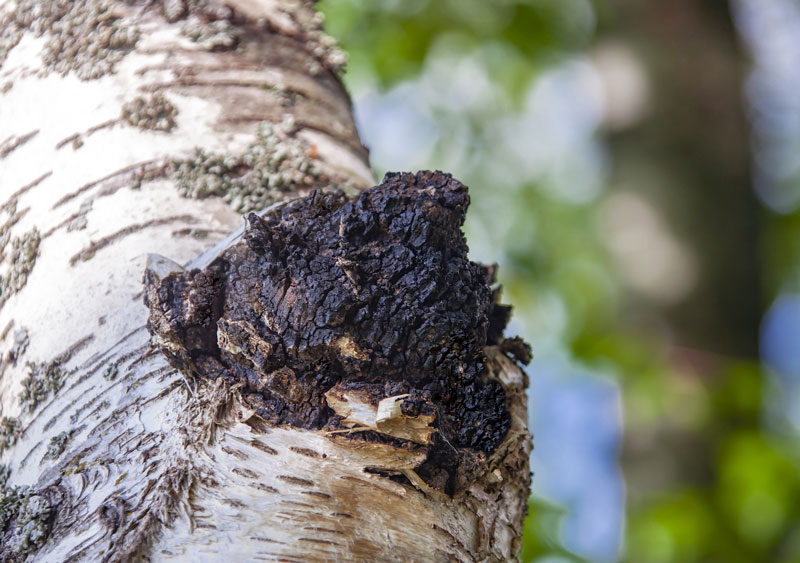 For the sake of this post we will focus more on Chaga because of its potent anti-oxidant properties along with its ability to support a healthy inflammatory response making it particularly appealing and promising. Known officially as Inonotus obliquus, Chaga is a type of fungus that grows primarily on birch trees in colder regions of the Northern Hemisphere, including parts Europe, Asia, and North America, including countries like Russia (especially Siberia), Finland, Canada, and the United States. It is known for its unique coal-like appearance and its traditional use in folk medicine. Chaga mushrooms have a long history of use in traditional medicine, particularly in Russia, Siberia, and other parts of Eastern Europe. They contain melanin, polysaccharides, and triterpenes, which possess antioxidant and immune-supporting properties. They also contain a range of antioxidants, including polyphenols, which may help combat oxidative stress and support a healthy inflammatory response in the body. Chaga is said to support digestion, liver health, and overall well-being.*
For the sake of this post we will focus more on Chaga because of its potent anti-oxidant properties along with its ability to support a healthy inflammatory response making it particularly appealing and promising. Known officially as Inonotus obliquus, Chaga is a type of fungus that grows primarily on birch trees in colder regions of the Northern Hemisphere, including parts Europe, Asia, and North America, including countries like Russia (especially Siberia), Finland, Canada, and the United States. It is known for its unique coal-like appearance and its traditional use in folk medicine. Chaga mushrooms have a long history of use in traditional medicine, particularly in Russia, Siberia, and other parts of Eastern Europe. They contain melanin, polysaccharides, and triterpenes, which possess antioxidant and immune-supporting properties. They also contain a range of antioxidants, including polyphenols, which may help combat oxidative stress and support a healthy inflammatory response in the body. Chaga is said to support digestion, liver health, and overall well-being.*
Chaga mushrooms grow as a parasitic fungus on living birch trees, typically birch species such as Betula pendula and Betula pubescens. The mushroom develops as a mass of mycelium, the underground network of fungal threads, which extends into the inner bark of the birch tree. Chaga obtains nutrients from the tree and slowly forms a hard, black, and irregularly shaped growth known as a sclerotium on the tree’s trunk or branches. The growth process of Chaga can take several years. It begins when the spores of the fungus enter wounds or damaged areas on the birch tree, initiating the infection. Over time, the mycelium grows within the tree, causing the formation of the Chaga mushroom on the outer bark. As the mushroom matures, it absorbs nutrients from the tree and eventually releases reproductive spores.
Harvesting Chaga mushrooms involves carefully removing the sclerotium from the birch tree without causing excessive damage to the host. It’s important to note that sustainable harvesting practices should be followed to ensure the long-term health of both the mushroom and the birch tree. After harvest, Chaga can be processed and prepared for various uses, such as making teas, extracts, tinctures, or supplements. Traditionally it was brewed as a tea as well as made into a wine. These products are typically obtained by drying and grinding the Chaga sclerotium into a fine powder (quite a chore because of its hardness) or brewing it into a decoction. It’s worth noting that while Chaga can be found growing in the wild, the quality, purity, and safety of commercially available Chaga products can vary. If you are interested in using Chaga or its products, it is advisable to source them from reputable suppliers who adhere to quality standards and sustainable harvesting practices.
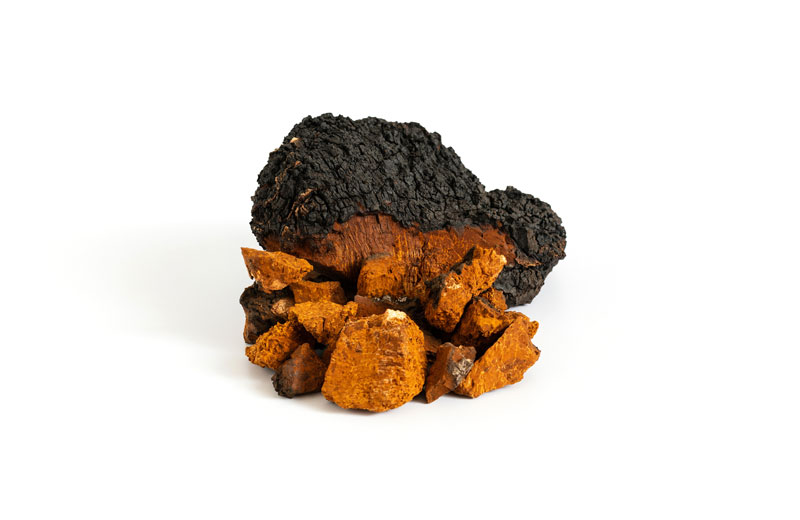 Chaga mushroom has a distinctive black, charcoal-like appearance and a hard, woody texture. It typically grows as a mass of mycelium on the outer bark of birch trees. While the mushroom itself is the reproductive part of the fungus, it is the mycelium that is commonly harvested for medicinal purposes. Because of its hard, wood nature it is essential that it be extracted in order to make the constituents available to the body.
Chaga mushroom has a distinctive black, charcoal-like appearance and a hard, woody texture. It typically grows as a mass of mycelium on the outer bark of birch trees. While the mushroom itself is the reproductive part of the fungus, it is the mycelium that is commonly harvested for medicinal purposes. Because of its hard, wood nature it is essential that it be extracted in order to make the constituents available to the body.
Chaga mushroom is well-known for its potent antioxidant properties. Antioxidants are compounds that can help neutralize or inhibit the harmful effects of free radicals, which are highly reactive molecules that can cause oxidative damage to cells and tissues. Here are some ways in which Chaga exhibits antioxidant actions*:
- Scavenging of free radicals: Chaga contains a variety of bioactive compounds, including polyphenols, melanin, and triterpenoids, which act as antioxidants. These compounds can directly interact with free radicals, donating electrons to neutralize their reactivity and prevent them from causing oxidative damage.*
- Superoxide dismutase (SOD) activity: Chaga has been found to possess superoxide dismutase activity, an important antioxidant enzyme in the body. SOD helps convert superoxide radicals, a type of free radical, into less harmful molecules, reducing the oxidative stress and damage they can cause.*
- Inhibition of lipid peroxidation: Chaga’s antioxidant compounds have been shown to inhibit lipid peroxidation, a process in which free radicals attack and damage lipids (fats) in cell membranes. By preventing lipid peroxidation, Chaga helps maintain the integrity and function of cell membranes.*
- Enhancement of endogenous antioxidants: Chaga has been reported to stimulate the activity or expression of endogenous antioxidants in the body. For example, it may enhance the production of glutathione, a powerful antioxidant that plays a crucial role in cellular defense against oxidative stress.*
- Reduction of oxidative stress markers: Studies have demonstrated that Chaga can reduce the levels of oxidative stress markers, such as malondialdehyde (MDA) and reactive oxygen species (ROS), in cells and tissues. This indicates its ability to counteract the harmful effects of oxidative stress.*
The antioxidant actions of Chaga are thought to contribute to its potential health benefits, including protection against cellular damage, support for immune function, and potential anti-inflammatory effects. However, it’s important to note that the specific mechanisms and effects of Chaga’s antioxidants are still being studied, and further research is needed to fully understand their impact on human health. Chaga is also said to support digestion, liver health, and overall well-being.*
 It’s important to note that while Chaga mushroom shows promise as a functional mushroom, individual experiences and outcomes may vary. As with all mushrooms, but in many ways more so with Chaga, it is essential to look for a quality product. First of all, make sure you Chaga is extracted, it’s coal-like consistency makes it virtually impossible to digest. Second, Chaga should be sourced from birch trees since they are the source for one of its key actives, betulin/betulinic acid. Chaga grown on other sources, particularly grain, will be lacking in the key constituent.
It’s important to note that while Chaga mushroom shows promise as a functional mushroom, individual experiences and outcomes may vary. As with all mushrooms, but in many ways more so with Chaga, it is essential to look for a quality product. First of all, make sure you Chaga is extracted, it’s coal-like consistency makes it virtually impossible to digest. Second, Chaga should be sourced from birch trees since they are the source for one of its key actives, betulin/betulinic acid. Chaga grown on other sources, particularly grain, will be lacking in the key constituent.
Mushrooms and Wellness
While the focus on mushrooms is often on their use for specific conditions and applications, I believe their greatest gift lies with their abilities to support the overall health, wellness, vitality and function of the whole human body. The fact that so many mushrooms support the body’s health as both endogenous and exogenous anti-oxidants just confirms this.
